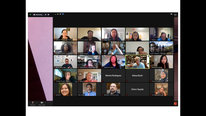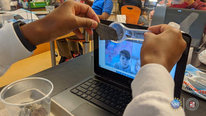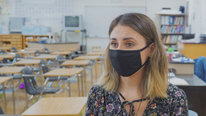
JOHN COLEMAN
Competency Performance Recording for Learning (CPR-L): An Innovative Teaching...
NSF Awards: 1439848
Competency Performance Recording for Learning (CPR-L) is a teaching and learning process that “resuscitates” learning of the analytical process of problem solving. It’s development began during LUs initial (NSF) HBCU-UP grant (2003-2008), aimed at correcting some of the teaching and learning problems students experienced. Too many students were achieving less than 40% pass ratio in STEM college introductory courses. Pre- and post-testing data from 12 years of testing our pre-college math and science program participants, as well as pre-testing results of entry level university STEM students, suggested systemic math and science deficiencies. Further, among a large number of incoming students, test results demonstrated a marked lack of comprehension with “reading problems.” Likewise, their responses, when attempted, demonstrated a troubling shortfall in the ability to express thoughts coherently or logically. Although unacceptable, class grades and learning issues mirrored that which was documented by a number of sources. The CPR-L process incorporates tasks and exercises aimed at impacting retention of information, understanding of course concepts, maintaining the integrity of the problem-solving process, and exorcising bad learning habits. The process includes exercises that: 1) Thoroughly understanding the problem before proceeding to solve it. 2) Following problem solving process and protocols. 3) Writing something down to aid in conceptualizing- sketching the concept of problems. 4) Speaking aloud when possible to engage the auditory learning channel. 5) Multiple repetitions of applying concept/ process. 6) A simulated going-to-the-board experience which provides an opportunity to dissect the problem solving process. 7) Teaching/demonstrating the concept in a simulated teaching exercise. The student records the problem solving process, and the a/v output reveals how well a student understands and can apply key course concepts, and where intervention is needed.
This process is being continuously refined, and is currently being applied among participants in LU's Robert Noyce STEM Teachers Scholarship program (NSF-1439848).
Resources:
Competency Performance Recording for Learning (CPR-L): An Innovative Teaching...
NSF Awards: 1439848
Competency Performance Recording for Learning (CPR-L) is a teaching and learning process that “resuscitates” learning of the analytical process of problem solving. It’s development began during LUs initial (NSF) HBCU-UP grant (2003-2008), aimed at correcting some of the teaching and learning problems students experienced. Too many students were achieving less than 40% pass ratio in STEM college introductory courses. Pre- and post-testing data from 12 years of testing our pre-college math and science program participants, as well as pre-testing results of entry level university STEM students, suggested systemic math and science deficiencies. Further, among a large number of incoming students, test results demonstrated a marked lack of comprehension with “reading problems.” Likewise, their responses, when attempted, demonstrated a troubling shortfall in the ability to express thoughts coherently or logically. Although unacceptable, class grades and learning issues mirrored that which was documented by a number of sources. The CPR-L process incorporates tasks and exercises aimed at impacting retention of information, understanding of course concepts, maintaining the integrity of the problem-solving process, and exorcising bad learning habits. The process includes exercises that: 1) Thoroughly understanding the problem before proceeding to solve it. 2) Following problem solving process and protocols. 3) Writing something down to aid in conceptualizing- sketching the concept of problems. 4) Speaking aloud when possible to engage the auditory learning channel. 5) Multiple repetitions of applying concept/ process. 6) A simulated going-to-the-board experience which provides an opportunity to dissect the problem solving process. 7) Teaching/demonstrating the concept in a simulated teaching exercise. The student records the problem solving process, and the a/v output reveals how well a student understands and can apply key course concepts, and where intervention is needed.
This process is being continuously refined, and is currently being applied among participants in LU's Robert Noyce STEM Teachers Scholarship program (NSF-1439848).
Resources:
-
 Virtual Learning Communities in STEM
Virtual Learning Communities in STEM
Deb Cole
-
 STEM Leadership
STEM Leadership
Mark Oursland
-
 Supporting Science Teachers Leaders in Virtual Learning
Supporting Science Teachers Leaders in Virtual Learning
Carolyn Nichol
-
 Explorations of Culturally Responsive STEM Pedagogies
Explorations of Culturally Responsive STEM Pedagogies
Kristin Rainville
-
 Noyce Scholars and Supervision in COVID-19
Noyce Scholars and Supervision in COVID-19
Stephanie Arthur
-
 You Deserve A Seat at The Table: The Data Economy Workforce
You Deserve A Seat at The Table: The Data Economy Workforce
Junell McCall
1824 Views
Continue the discussion of this presentation on the Multiplex. Go to Multiplex
1824 Views
presentation
has been viewed
Related videos you might be interested in...
-
 Virtual Learning Communities in STEM
Virtual Learning Communities in STEM
Deb Cole
-
 STEM Leadership
STEM Leadership
Mark Oursland
-
 Supporting Science Teachers Leaders in Virtual Learning
Supporting Science Teachers Leaders in Virtual Learning
Carolyn Nichol
-
 Explorations of Culturally Responsive STEM Pedagogies
Explorations of Culturally Responsive STEM Pedagogies
Kristin Rainville
-
 Noyce Scholars and Supervision in COVID-19
Noyce Scholars and Supervision in COVID-19
Stephanie Arthur
-
 You Deserve A Seat at The Table: The Data Economy Workforce
You Deserve A Seat at The Table: The Data Economy Workforce
Junell McCall
John Coleman
Associate Professor; Department Chair-Chemistry/Physical Sciences
Hello and welcome. Thank you for stopping by. Our presentation is entitled “Competency Performance Recording for Learning (CPR-L)”, so named because it “resuscitates” learning of the analytical process of problem solving. It incorporates tasks and exercises aimed at impacting retention of information, understanding of course concepts, maintaining the integrity of the problem-solving process, and exorcising bad learning habits. Data for STEM courses taught using CPR-L showed an improvement of up to 212% in pre and post text scores, compared to an 85% improvement without the CPR-L process.
An overview of how the process works and its major benefits are listed in the Abstract section at the top right on this page. Also, CPR-L is one of the best tools we have found to curtail students’ propensity to use pattern-matching and plug-and-play, or to incorrectly or surreptitiously use tools such as Chegg, instead of applying appropriate concepts to solve homework problems. The repetition required to produce a time-limited, concise recording of the process applied in solving homework problems means that the student must get involved at a relatively deep level. The recording aids in pinpointing precisely where the student failed to understand the problem and/or process, permitting the instructor to successfully intervene. It also validates a students’ grasp of the concept when done successfully.
The CPR-L process is equally effective during online or in-person learning.
I would appreciate any questions that you have about the CPR-L process. If I don’t get to answer them during the Showcase, please drop me an email at jkcoleman@langston.edu and I will arrange a time to talk to you. I’d love to hear your thoughts about the CPR-L process, and more importantly, I’d love to hear how you are addressing the issues addressed here.
Anne Kern
Professor
Hello CPR-L Team,
I agree the "plug and play" method of evaluation (and teaching for that matter) is antiquated and does not really allow students to demonstrate conceptal knowlege! I would really like to have seen what one of these "CPR-L" asssessments or learning modules looked like. Perhaps you could also send me to a place or link to observe of "CPR-L" in action!
How similar is the "CPR-L" activity to say "POGIL" activities?
Also, I am curious what you mean by a 212% improvement?
Thanks for sparking my interest!
Anne
Joyce
I want to hear more about cprl
Crystal James
This is awesome and critical for K12 and undergraduate students who are asked to digest many different complex concepts across many disciplines. Are there specific assessments that are used to demonstrate competency mastery?
John Coleman
Associate Professor; Department Chair-Chemistry/Physical Sciences
Thank you for your comment. Absolutely, the CPR-L process utilizes a rubric to guide the student in using an analytical problem solving process to obtain their solution. This rubric is also used to assess how well the student complies with this process. The recording reveals any gaps in the student's understanding of the problem as well.
Junell McCall
This is an excellent presentation and much needed to improve students' competencies as well as self-efficacy. I am intrigued by your CPR-L process and see an avenue for collaboration. My research is focused on students' self-efficacy to perform data tasks.
Helen Burn
This is a very interesting approach to learning. I'd like to see how this works in practice. Great presentation and so much passion in your work.
John Coleman
Associate Professor; Department Chair-Chemistry/Physical Sciences
Thank you for your interest. The CPR-L process has some similar traits as the POGIL activities but is quite different. CPR-L is primarily used for homework assignments. The student is required to record their homework assignments completely on tablet PC, narrating the process step-by-step as though they were teaching the concept presented. They must explain each step of their solution process, including verifying their understanding of the problem before proceeding. They are guided by an analytical problem-solving rubric to hard-wire the process. Multiple iterations are required to produce a time-limit concise recorded product. Both hard copy and recording are submitted. The recording reveals any gaps or successes of the student’s analytical problem-solving abilities.
The Pre & Post tests were given to high school students who attended an Annual residential summer 4-week Math & Science academy at Langston to assess their progress. The results reflect data for the chemistry class over a five-year period, 2008-2012. It compares tests results when CPR-L was utilized to the period before it was utilized. The Instructor for all the classes was the same.
To view a CPR-L sample, go to the link: stemdigitalvillage.com From the CPR-L tab choose CPR-L samples.
Ann Cavallo
Assistant Vice Provost and Director, CRTLE
Hi John, I have done this type of work in genetics learning and published (just a few years ago now, lol) - I was not able to open your link. What was your theoretical framework/research base for the CPR-L - Vygotsky, Anderson? Very interesting!
Ann Cavallo
Assistant Vice Provost and Director, CRTLE
Thank you for sharing this video! It is so important for students and pre-service teachers to move away from simple memorization and build a foundation of meaningful conceptual understanding, logic, and reasoning to solve problems. Doing so develops the mind over their lifetime, where, as you know, memorized facts and formulas are forgotten. The method you describe sounds something like the "think aloud protocols" we used to use to collect data on problem solving back in the day(!). Do you code and find common gaps in understanding among students (and/or teachers) that can later be re-taught? Do you use scaffolding - that is, in addition to problem solving and describing "how" they are solving, students also have to describe the conceptual meaning and logic of the problem in each step (or guidance can be provided by the teacher)? I am thinking for example, in solving a genetics problem - students can solve Punnett square diagrams and talk through how they are solving it - and they can arrive a correct diagram - but an important part is the conceptual part - what do the letters B and b in the diagram represent? Where is B and b in a cell, in a living organism? Why might they combine in these ways? This involves engaging both procedural (how) and declarative/conceptual (what/why) knowledge to be most successful. Also, what are some examples of problems your teachers used the model to work through? Thanks!
John Coleman
Associate Professor; Department Chair-Chemistry/Physical Sciences
Dr. Ann Cavallo, thank you for your interest. Based on your comments it appears CPR-L could be a perfect solution for you. One of my former students summed up CPR-L impact perfectly. He learned that he was looking at the problem as a whole pie and completely oblivious to the pieces of the pie.
Two of the major hurdles that students face in problem-solving are first, completely understanding the problem before proceeding toward solution, the second is identifying and linking the key components to the solution.
We have two categories of rubrics for guidance.
The general analytical problem-solving rubric guides the student through the proper steps of problem solving, including directing them to identify and include the relevant components.
The instructional rubric goes further, (which is good for students as well as instructors). It includes each relevant component that must be considered for solution. I believe, this is the one you inquired about. I have samples of each; let me know if you would like a copy.
One of the unanticipated outcomes is that students become motivated to produce albums of their work. Self-efficacy at work.
To view a CPR-L sample, go to the link: stemdigitalvillage.com From the CPR-L tab choose CPR-L samples.
Ann Cavallo
John Coleman
Associate Professor; Department Chair-Chemistry/Physical Sciences
The URL for locating CPR-L samples should be entered as stemdigitalvillage.com
Choose CPR-L TAB , then choose CPR-L samples.
Thomas Veague
Thanks for sharing this impressive program through your video! It's great to see that the primary benefits were seen in both in-person and online teaching. You mentioned that there was a change in time investment with the switch to distance learning. How did the implementation of CPR-L change during this time?
John Coleman
Associate Professor; Department Chair-Chemistry/Physical Sciences
Thanks for the question. The university had to make a significant investment in technology to support the switch to the distance learning environment, further improving the technology platforms throughout the university. This inadvertently improved the opportunity for and facilitation of the CPR-L program.
Elizabeth Allan
Professor; Secondary Science Education Program Coordinator
Great project that gives us all a chance to think about our own practices with our students.
When student are "narrating the process step-by-step as though they were teaching the concept presented" do you find them having "eureka" moments when they are able to link what they are saying to a particular concept they were struggling with? and, does it allow them to look back on prior knowledge and re-think their understandings?
John Coleman
Associate Professor; Department Chair-Chemistry/Physical Sciences
Absolutely, Most of my quotes come from students who have arrived at their "eureka" moment. The student's entire perspective begins to change; further, the conversations among their peers also evolve. The student is reluctant to record anything that might make them look 'dumb' (their word). If a peer decides to help they can no longer say ' you just multiply those two numbers and subtract that one and get the answer'. Now the student demands, 'why?' because they've got to explain 'why?'
John Coleman
Associate Professor; Department Chair-Chemistry/Physical Sciences
Dr. Cavallo most of the CPR-l exercises have been in chemistry and physics. The link to a few CPR-L samples is: stemdigitalvillage.com
Ann Cavallo
Ann Cavallo
Assistant Vice Provost and Director, CRTLE
Very nice - thanks John!
John Coleman
Associate Professor; Department Chair-Chemistry/Physical Sciences
Dr. Cavallo, the CPR-L process was initially developed to assist students in hard-wiring the 'the problem solving process' and impacting their retention of information. However, the CPR-L process is aligned with most of the protocols presented in Blooms Taxonomy including requiring the student to create an original problem based on concepts learned.
Ann Cavallo
Jane Coffee
Hi John,
I certainly recognized a number of the problems that you described. A question: Have you been able to get some colleagues to buy into CPR-L? If yes, how did you do it?
John Coleman
Associate Professor; Department Chair-Chemistry/Physical Sciences
Colleagues that seem to recognize the problem and the extent of it, and wish to be part of the solution seem to be much more amenable. The most limiting factor is the lack of availability of tablet PC’s for all students. Appropriate technology is key in making a smooth implementation. Because results of this process are quite phenomenal, some of my colleagues have adopted it on a limited bases. Currently I'm seeking funding to gather data across a broader cohort group. Incidentally, the pattern matching process among students that I taught was ‘alive and well’ when I worked at CUNY in Brooklyn during the 90’s.